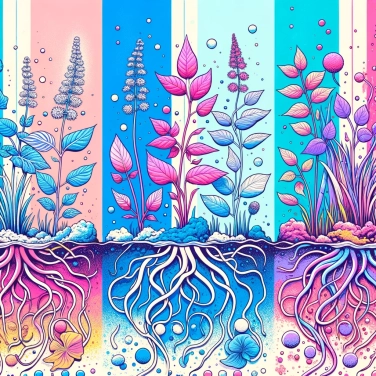Some plants change color depending on the acidity of the soil because it affects the availability of nutrients such as iron, and thus the production of pigments responsible for the color of the leaves.

The color we perceive in a plant mainly depends on molecules called plant pigments. Among the most important are chlorophyll, famous for its green hue, but also anthocyanins, responsible for red, blue, or purple colors, and carotenoids, which give rise to yellow or orange tones. These pigments capture light and play an essential role in photosynthesis, but they also serve to attract pollinating insects or to protect the plant from overly aggressive UV rays. Their hue can vary according to their concentration, their mixture, and sometimes even due to chemical interactions related to their immediate environment, particularly the soil.
The soil pH strongly determines the quantity and form of nutrients available to a plant, and thus directly influences its colors. An acidic soil often alters the availability of certain metals like aluminum, which is released in large quantities. This soluble aluminum then easily interacts with plant pigments, leading to a modification of their initial hue. Conversely, in a more alkaline soil, other elements like iron become less accessible to the roots. This deficiency can decrease the production of certain essential pigments — such as chlorophyll — causing yellowing or slight variations in color.
The main culprits behind the phenomenon are pigments called anthocyanins. These pigments, naturally present in the vacuole of plant cells, change color depending on the acidity or alkalinity of the medium in which they are found. When the pH is acidic, anthocyanins typically take on bright red to pink hues; conversely, when the environment becomes more alkaline, their hue shifts toward purple or even blue. This occurs on a molecular scale: depending on the level of acidity, the chemical structure of these pigments changes very slightly, directly affecting how they absorb and reflect light. What is fascinating is that these molecular modifications are reversible as soon as the soil pH changes again.
The hydrangea is undoubtedly the most well-known case: in acidic soils (low pH), it turns deep blue, while in alkaline soils (high pH), its flowers take on a pink or even reddish hue. The color varies because in acidic soil, the aluminum present in the earth becomes available to the plant and interacts with its pigments. Another nice example is the azalea, whose colors are often brighter and more vibrant in acidic soil. The soil pH also slightly influences the shade of certain rhododendrons, giving them more intense tones when the acidity is higher. Finally, some edible plants like red cabbage also subtly change color depending on the acidity of the soil, ranging from purple-red to bluish-green.
Today, scientists are mainly studying how anthocyanins (pigments responsible for beautiful changing colors) chemically interact with soil minerals according to its acidity. Some labs are trying to precisely isolate the genes involved to create innovative varieties that can better indicate pH changes. Others are even attempting to measure whether these color variations accurately reflect soil health, in order to use them as rather cool natural indicators. A few researchers are also working on how to enhance this phenomenon in plants that do not naturally have it, in order to expand the range of available plant species to decorate our gardens according to our color preferences.
The term "anthocyanin" comes from the ancient Greek words anthos ("flower") and kyanos ("blue"), highlighting the unique ability of these pigments to produce varying shades depending on the acidity of their environment.
It is easy to measure the pH of your soil using red cabbage: by preparing a juice from its leaves, you will obtain a natural indicator solution that will change color depending on the acidity or alkalinity of the tested soil!
Infused black tea can slightly acidify alkaline soil, thus providing a natural method to delicately adjust the pH of soils intended for certain ornamental plants sensitive to pH.
Not all plants change color with pH; only those possessing specific pigments called anthocyanins have the fascinating ability to display their acidic or basic condition through their colors.
Hydrangeas are sensitive to soil pH. An acidic soil (low pH) encourages the release of aluminum ions that the hydrangea absorbs, resulting in blue flowers. Conversely, in alkaline soil (high pH), aluminum is less available, so hydrangeas absorb elements that promote a pink coloration.
Sure! Here’s the translation: "Yes, several plants are sensitive to pH, including azaleas, rhododendrons, camellias, and certain Japanese maples. These plants may exhibit color changes or develop nutritional deficiencies depending on the soil's acidity level."
Not necessarily. The color change due to pH is often a natural phenomenon related to the interaction between pigments and soil nutrients. However, a pH that is too far from a plant's specific needs can lead to nutrient deficiencies that may compromise its overall health.
The pH measures the acidity or alkalinity of a soil. It is crucial because it directly affects the availability of nutrients and minerals essential for plants. Depending on the pH, these nutrients are more or less easily absorbable, thereby influencing the growth, health, and even the color of the plants.
Soil pH test kits are available at garden centers and online. There are also natural methods to roughly determine pH, such as observing indicator plants that grow spontaneously or conducting a test using vinegar or baking soda.
Yes, you can modify the pH of your soil, although this process takes time. Adding elemental sulfur or peat acidifies an alkaline soil, while agricultural lime or wood ash raises the pH of overly acidic soil. Changes should be monitored regularly to avoid significant imbalances.

10% of respondents passed this quiz completely!
Question 1/5